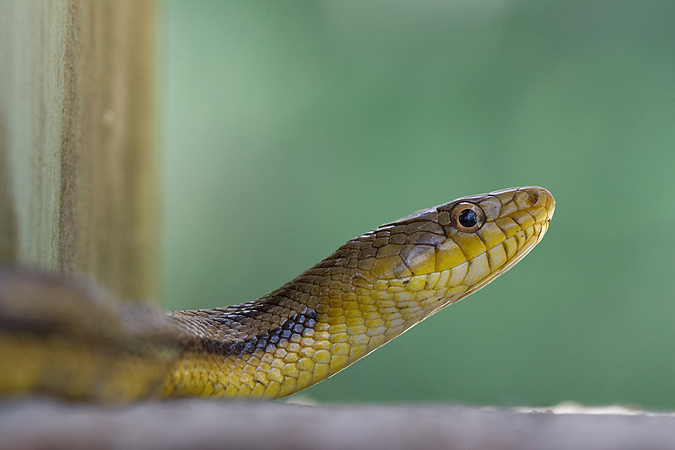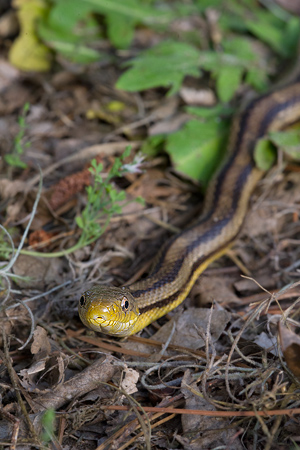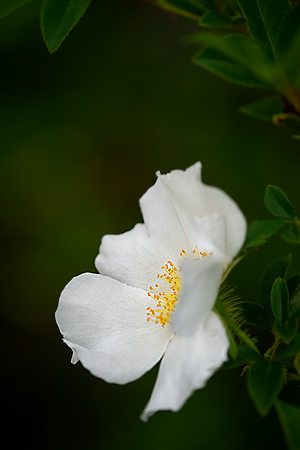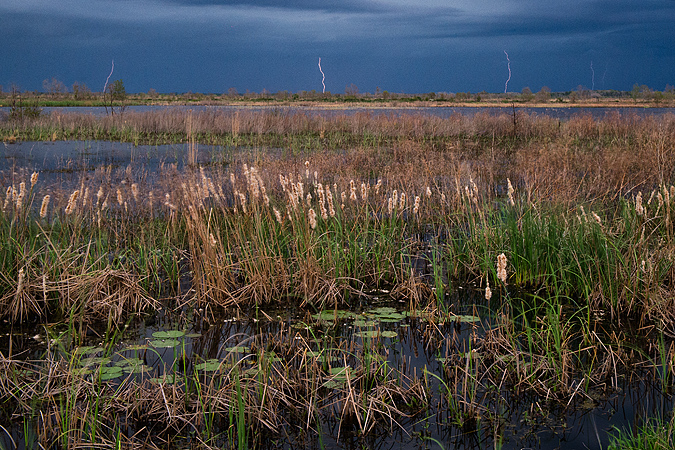Today was all about reptiles. I should have known it from the start. As I got near Savannah National Wildlife Refuge, there was a large Softshell Turtle that some people were helping cross the road. A few yards later, I swerved slightly to avoid a small Slider also crossing. The refuge has been drying one of the large ponds, so for the last few days there have been a lot of turtles leaving the pond before it dries completely. I entered the refuge and for a little while worked a Common Moorhen. A little later, I found myself watching a large flock of Cedar Waxwings. These birds won’t be around much longer – they’ll head up north to their summer ranges. But for now they were foraging on some bright red holly berries. Waxwings and red berries: ingredients of a great image. I watched the flock to see if they would feed on some of the lower berries instead of at the top of the tree. No such luck, but I noticed something fall out of the corner of my eye from a tree. At first I thought it was a branch, leaf, or some spanish moss. But I did a double take and thought, either that’s a big branch or else a snake had just dropped down. In these kinds of situations, you move fast. The opportunity doesn’t last. I left my 600mm next to my car and quickly swapped on a macro lens and went over to see if there was an opportunity. A beautiful Eastern Rat Snake had dropped out of the tree and was starting to move. Working handheld, I was able to get some close-up shots. Most people don’t like snakes. Personally, I like all sorts of wildlife and snakes are no exception. Photos of a snake have little sales potential, but that’s why not I take photos. First and foremost, I must enjoy the moment and that’s what I had here. Down in southern South Carolina, Georgia, and Florida the rat snakes aren’t black like they are further north, but take on a lovely yellow coloration.
The rat snake had decided to drop into this little information booth of the refuge. I really don’t like having anything man-made in my wildlife images. The snake is in no way tame or captive and spends 99% of its time far from anything related to people. So to minimize this, I went in close, real close. After a while, the snake slithered its way into the grass. I had just a brief bit of time before it entered the brush going about its business. Try photographing a small animal in the grass sometimes. Those tiny blades are everywhere. Again the solution is to go in close and in this case to think ahead. Be ready for when the snake will come into the open and work to get as clean of a background as you can and a pleasing composition. While I take some close-ups, they are not my favorites. Animals are not just a head. Snakes, especially are all about their long slender bodies. So I try to work this into a photo if I have an opportunity. Even in the close-up, I keep a suggestion of the snake’s long body. I was prepared for the snake going into the open, but I was not prepared for what it did. Some of the things you see in the course of wildlife photography just defy explanation. For sure the snake knew I was there when I was photographing. At first it was wary of me. When it moved into the grass and I moved along with it, it stopped to stare at me. Then unexpectedly, it changed course and came right up to me, gently touched my leg, and then headed back to where it originally was headed. Was it curious, did it have something on its mind? I have no idea and don’t like to project human feelings onto an animal. But I do know for certain that it knew I was there and came up to me rather than just happening to cross paths.
After the fun with the rat snake, the weather started to turn and turn fast. Storms came and the sky took on some great dark colors. This made conditions perfect for some of the beautiful wild roses that have started to flower on the refuge. The roses make for a much more stationary subject than snakes. If it wasn’t for the pressing storms, I’d feel like I had all the time in the world to work this subject. Wild roses are not like their raised, familiar cousins. The wild ones are usually unfurled and the petals form a single layer. This gives wild roses a very different look from the flowers you find at a florist, but I like the natural simplicity of the wild variety.
The storm clouds moved in quickly. They drastically reduced the light, but gave some of that unique light that you see on rare occasions. With the storm clouds came lightning in the distance. By this point I was in an experimental mood. The lightning gave me a few ideas. Using a neutral density filter to cut down on the light, gave me very long exposure times even though it was still light out. This makes capturing the lightning much easier. The experiment failed in my mind – got the lightning but not much else. The marshes are still a bit ugly with too much of the death left over from winter. Also, in the future I think I need to put the lightning large in the frame to capture its power, but the neutral density filter I have doesn’t fit my telephotos. Step one – getting the lightning in the image – was accomplished, but there are a few more steps before a good lightning photo.




